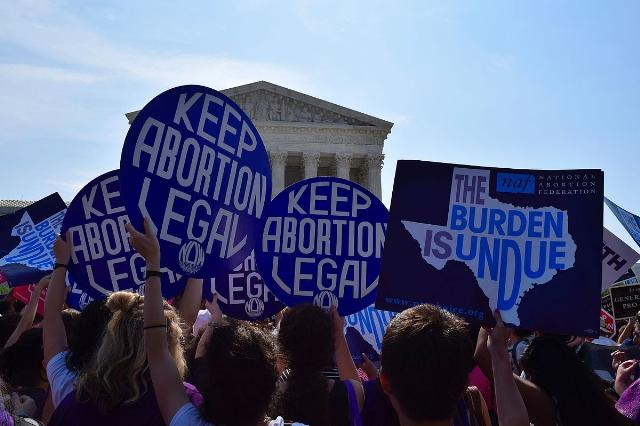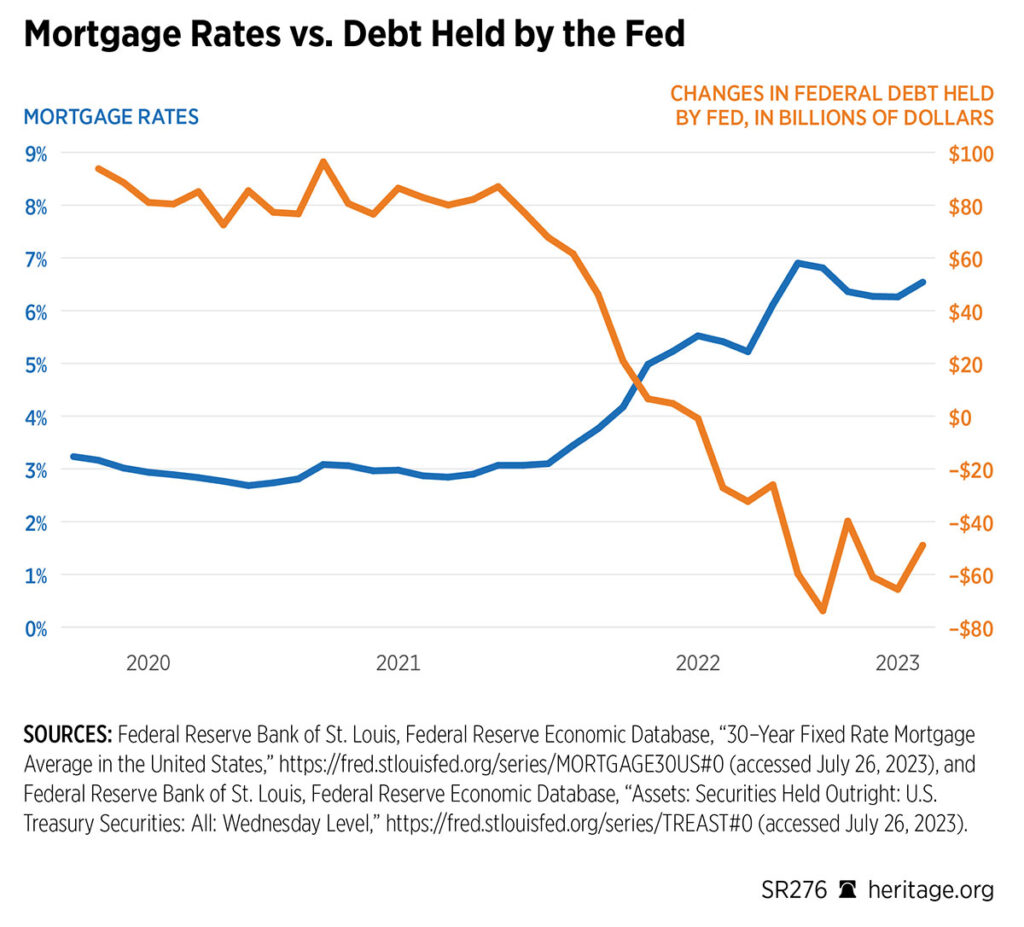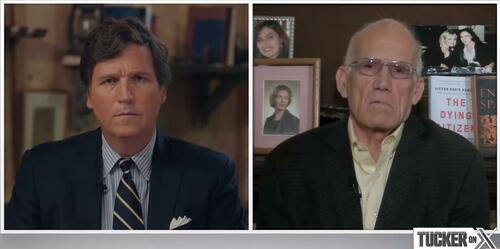With The Bloodbath Hoax having been so swiftly and thoroughly debunked, the evening network newscasts had to scramble to find ways to keep this narrative alive. It appears that they’ve settled on wrapping this latest hoax around the Capitol Riot of January 6th, thus magically eliminating the need for context.
No surprise here, the most hysterical report comes via ABC World News Tonight and Jon Karl, who acknowledged that former President Donald Trump’s remarks were in fact about the automotive industry, before making them about January 6th:
JON KARL: Today Donald Trump is defending comments he made at a rally in Ohio warning of a quote, “bloodbath” if he doesn’t win the presidential election in November. Trump made the comment as he was talking about the auto industry, vowing to impose 100% tariffs on some imported cars.
DONALD TRUMP: We’re going to put a 100% tariff on every single car that comes across the line, and you’re not going to be able to sell those cars- If I get elected. Now, if I don’t get elected, it’s going to be a bloodbath for the whole — that’s going to be the least of it. It’s going to be a bloodbath for the country. That’ll be the least of it.
KARL: Today, Trump insisted he wasn’t talking about political violence at all, saying, quote, “I was simply referring to imports allowed by Crooked Joe Biden, which are killing the automobile industry.” But the world saw what happened the last time Trump lost a presidential election, as Trump’s supporters violently attacked the Capitol on January 6th.
There has been a tactical evolution here. Trump’s remarks are now acknowledged as being about Chinese electric cars potentially built in Mexico (a grossly underreported story, as I said to Tim Graham on the NewsBusters Podcast), but here’s the new switcheroo: the full quote has Trump bracketing the “bloodbath” quote with remarks on the automotive industry. Chopping that last part off, even when restoring context in the beginning of the quote, keeps everything vague enough to keep the Bloodbath Hoax plausible and duct-tape January 6th onto it. Now there’s a fresh angle. And for Karl, perhaps, a fourth Trump book.
NBC ran The Bloodbath Hoax as part of its recap of Trump stories as opposed to a standalone item, but with the same basic play:
GARRETT HAAKE: And tonight the presumptive GOP nominee also pushing back, saying Democrats, quote, “pretended to be shocked at my use of the word bloodbath” during this riff about Chinese car makers.
TRUMP: We’re going to put a 100% tariff on every single car that comes across the line. And you’re not going to be able to sell those cars. If I get elected. Now, if I don’t get elected, it’s going to be a bloodbath for the whole — that’s going to be the least of it. It’s going to be a bloodbath for the country. That’ll be the least of it.
HAAKE: Mr. Trump saying he was referring to President Biden allowing imports he says are killing the auto industry. Late tonight, calling Democratic attacks, quote, “misinformation”.
TRUMP: The word “bloodbath”, I used it about trade, essentially auto trade, because we’re getting ripped off with Biden’s really dumb auto policy.
HAAKE: The Biden campaign rejecting that it was about only cars.
MICHAEL TYLER: Every single day, Donald Trump is promoting and endorsing and encouraging political violence on the stump.
The slightly expanded quote with a bit of context but maintaining plausibility, the (indirect) tie-in to January 6th- it’s all there, with a few more quotes with which to provide the illusion of balance.
CBS’s Robert Costa runs the exact same play within his Trump recap, albeit with a slightly different angle. Wash, rinse, repeat:
ROBERT COSTA: Meanwhile, the former president has ramped up his incendiary rhetoric on the campaign trail.
DONALD TRUMP: We’re going to put a 100% tariff on every single car that comes across the line and you’re not going to be able to sell those cars. If I get elected. Now if I don’t get elected, it’s going to be a bloodbath for the whole — that’s going to be the least of it. It’s going to be a bloodbath for the country.
COSTA: Trump insists he was referring to a potential bloodbath in the automobile industry. In the past, Trump has warned of bedlam if Biden wins, suggesting there will be anger if he is convicted of a crime.
TRUMP: There will be bedlam in the country. It’s a very bad thing. It’s very bad precedent, as we say, it’s the opening of a Pandora’s box.
The strategy may have evolved in order to provide a smidgen of context, but it remains as shameless and as reliant on multiple suspensions of disbelief as ever. The title of “regime media” is well earned here.
Click “expand” to view the full transcripts of the reports respective as aired on their respective evening newscasts on Monday, March 18th, 2024:
ABC World News Tonight
DAVID MUIR: Back here at home tonight, and to the race for the White House, on the campaign trail, Donald Trump warning of a, quote, “bloodbath” if he loses the election. Tonight, his campaign and what Trump meant by that. The Biden campaign pointing to January 6th. The country and the world seeing what can happen amid dangerous rhetoric. And the moment Trump played the national anthem to honor those who are behind bars for January 6th. Here’s Jon Karl.
JON KARL: Today Donald Trump is defending comments he made at a rally in Ohio warning of a quote, “bloodbath” if he doesn’t win the presidential election in November. Trump made the comment as he was talking about the auto industry, vowing to impose 100% tariffs on some imported cars.
DONALD TRUMP: We’re going to put a 100% tariff on every single car that comes across the line, and you’re not going to be able to sell those cars- If I get elected. Now, if I don’t get elected, it’s going to be a bloodbath for the whole — that’s going to be the least of it. It’s going to be a bloodbath for the country. That’ll be the least of it.
KARL: Today, Trump insisted he wasn’t talking about political violence at all, saying, quote, “I was simply referring to imports allowed by Crooked Joe Biden, which are killing the automobile industry.” But the world saw what happened the last time Trump lost a presidential election, as Trump’s supporters violently attacked the Capitol on January 6th. And in Ohio, Trump paid tribute to those arrested for their actions on that day.
ANNOUNCER: Please rise for the horribly and unfairly treated January 6th hostages (The Star-Spangled Banner)
KARL: He saluted during a rendition of the National Anthem that was recorded by people in prison for what they did on January 6th. Trump called those now serving prison sentences hostages and patriots, suggesting he’d pardon them as soon as he gets back in office. Today, the Biden campaign condemned Trump’s prediction of a bloodbath, accusing him of having an "affection for violence" and a "thirst for revenge" and alleging Trump wants "another January 6th." Not long after Trump paid tribute to the people who attacked the Capitol as, quote, “unbelievable patriots", he posted multiple statements calling for Liz Cheney and other members of the January 6th committee to be prosecuted and sent to jail. In other words, David- Trump wants to pardon those who attacked the Capitol, and he wants to prosecute those who investigated his actions on January 6th.
MUIR: Jon Karl, covering the campaign for us. Jon, Thank you.
NBC Nightly News
LESTER HOLT: His criminal cases may be caught up in a cycle of delays, but things may have moved too quickly for former President Trump in the wake of that stunning civil fraud judgment against him last month. In a court filing today Mr. Trump’s attorneys saying they have been unable to secure the $464 million bond due next week, saying a bond in the full amount is a practical impossibility. The former president, who built his professional reputation in part on his wealth, was held liable last month for fraudulently overstating the value of assets. Today’s development potentially opens the door for New York’s state attorney general to seize and sell off Trump assets while Mr. Trump appeals. Meantime, the former president is on the political defensive tonight over some remarks he made over the weekend. Garrett Haake has our report.
GAARETT HAAKE: Tonight the fate of former President Trump’s most famous properties could be up in the air, with Trump attorneys telling a judge he’s unable to secure bond in the $464 million civil fraud judgment against him, asking a judge for an emergency stay. Guarantors won’t accept real estate as collateral but want nearly a half billion dollars in cash, which Trump’s company doesn’t have, his lawyers say. If he cannot post bond for the full amount by next week, Democratic New York Attorney General Letitia James could start seizing his assets, potentially even his Trump Tower penthouse. In their filing, Trump attorneys argue the penalty is grossly disproportional when there were, quote, “no victims, no damages and no actual financial losses” in the case. It comes as the Trump campaign also faces blowback amid Mr. Trump’s new inflammatory rhetoric against what he calls criminal migrants.
DONALD TRUMP: They’re not people in my opinion. But I’m not allowed to say that because the radical left says that’s a terrible thing to say. These are animals. Okay?
HAAKE: Mr. Trump has vowed to bring back his Remain in Mexico policy that keeps migrants waiting outside the U.S. until courts decide their asylum cases. The Biden administration is releasing 85% of migrants into the U.S. while they wait for asylum decisions. And tonight the presumptive GOP nominee also pushing back, saying Democrats, quote, “pretended to be shocked at my use of the word bloodbath” during this riff about Chinese car makers.
TRUMP: We’re going to put a 100% tariff on every single car that comes across the line. And you’re not going to be able to sell those cars. If I get elected. Now, if I don’t get elected, it’s going to be a bloodbath for the whole — that’s going to be the least of it. It’s going to be a bloodbath for the country. That’ll be the least of it.
HAAKE: Mr. Trump saying he was referring to President Biden allowing imports he says are killing the auto industry. Late tonight, calling Democratic attacks, quote, “misinformation”.
TRUMP: The word “bloodbath”, I used it about trade, essentially auto trade, because we’re getting ripped off with Biden’s really dumb auto policy.
HAAKE: The Biden campaign rejecting that it was about only cars.
MICHAEL TYLER: Every single day, Donald Trump is promoting and endorsing and encouraging political violence on the stump.
HOLT: And Garrett, NBC News also has new reporting tonight about President Biden showing some growing frustration about his re-election campaign. What do we know? HAAKE: Yeah, that’s right, Lester. President Biden shouted and swore about falling poll numbers in a January White House meeting, and has felt cocooned by staff, eager to move more aggressively in campaigning against Mr. Trump, sources tell NBC News. Lester.
HOLT: All right, Garrett Haake. Thank you.
CBS Evening News
NORAH O’DONNELL: We’re going to begin tonight with Donald Trump facing a cash crunch. The former president is on the brink of being forced to surrender some of his most valuable real estate properties to help pay that $454 million civil fraud judgment in New York. He’s already admitted that he doesn’t have the nearly half a billion dollars in cash, and today, his lawyers revealed that more than 30 firms that they were unable to or , quote, "unwilling" to accept the risk associated with such a large bond. The clock is now ticking with that bond due next week. It’s worth remembering the civil judgment stems from a ruling that Trump falsely valued parts of his real estate empire for financial gain. And then on the campaign trail, Trump is also defending himself after a series of disturbing remarks about migrants, January 6th defendants, and warning of a, quote, "bloodbath" if he loses in November. It was all while discussing tariffs on Chinese-made cars. CBS’s Robert Costa is here and he’ll start us off tonight.
ROBERT COSTA: Former President Donald Trump could soon be facing a financial crisis. His lawyers today revealing in a court filing that Trump has failed to obtain a $454 million bond, calling it a practical impossibility. It’s due in just one week and without it, New York Attorney General Letitia James could freeze his bank accounts and seize his prized properties, including Trump Tower and 40 Wall Street.
DONALD TRUMP: The bottom line is, this is rigged.
COSTA: Trump, who was unable to reach agreement with more than 30 companies that provide appeal bonds, is also scrambling to raise money for the general election. CBS News has learned Trump is considering enlisting his former 2016 campaign chairman, Paul Manafort, a convicted felon who was found guilty of committing several financial crimes in 2018 and later pardoned by Trump. Meanwhile, the former president has ramped up his incendiary rhetoric on the campaign trail.
TRUMP: We’re going to put a 100% tariff on every single car that comes across the line and you’re not going to be able to sell those cars. If I get elected. Now if I don’t get elected, it’s going to be a bloodbath for the whole — that’s going to be the least of it. It’s going to be a bloodbath for the country.
COSTA: Trump insists he was referring to a potential bloodbath in the automobile industry. In the past, Trump has warned of bedlam if Biden wins, suggesting there will be anger if he is convicted of a crime.
TRUMP: There will be bedlam in the country. It’s a very bad thing. It’s very bad precedent, as we say, it’s the opening of a Pandora’s box.
COSTA: Over the weekend, Trump also referred to migrants as animals, and described those convicted for crimes related to January 6th as hostages and patriots. That remark drawing criticism from both sides of the aisle.
MIKE PENCE: It’s just, it’s just unacceptable.
JAMIE RASKIN: A hostage is someone who is being held by a criminal group or a terrorist group for a financial or political ransom. That’s got nothing to do with people who have been criminally charged and given due process.
COSTA: Meanwhile, former Trump White House advisor Peter Navarro will likely be headed to jail. Today the Supreme Court rejected Navarro’s push to stave off his sentence for refusing to comply with the congressional subpoena and he is now set to report to a correctional facility tomorrow in Florida, Norah. That is some big news. Robert Costa, thank you.
via NewsBusters – Exposing Liberal Media Bias
Enjoy this article? Read the full version at the authors website: https://www.newsbusters.org/
![]()





 Despite learning from the native Indians how to plant, cultivate ,and harvest new crops in their first year, the Pilgrims complied with their sponsoring Virginia Company charter that called for settlement farmland to be owned and worked communally and for harvests to be equally shared. This socialist common property approach created disincentives to work. William Bradford recorded in his memoirs that while “slackers showed up late for work… everybody was happy to claim their equal share… and production only shrank.”
Despite learning from the native Indians how to plant, cultivate ,and harvest new crops in their first year, the Pilgrims complied with their sponsoring Virginia Company charter that called for settlement farmland to be owned and worked communally and for harvests to be equally shared. This socialist common property approach created disincentives to work. William Bradford recorded in his memoirs that while “slackers showed up late for work… everybody was happy to claim their equal share… and production only shrank.”